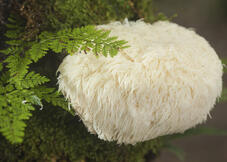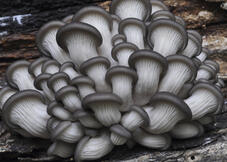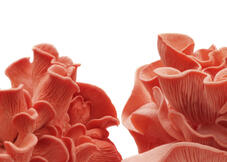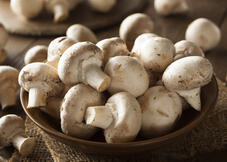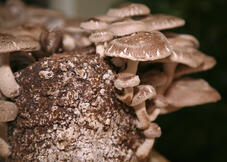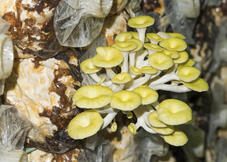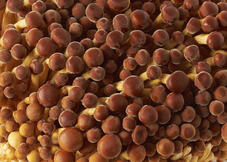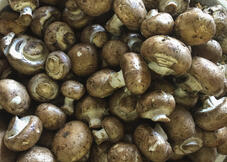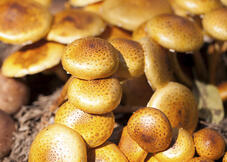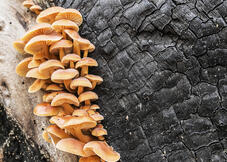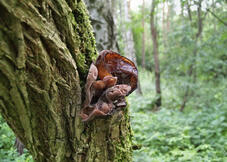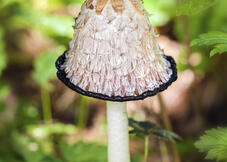Cultivating Your Own Mushrooms: Here’s How It’s Done
If you cultivate your own mushrooms, you can enjoy the delicacies fresh and free from harmful substances. Mushroom cultures are also very easy care and can be grown all year round.
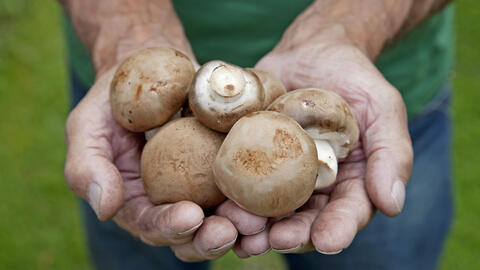
Brown button mushrooms are called chestnut mushrooms and are easy to cultivate. They have an intense, slightly nutty flavor and the flesh is also a little firmer than that of their white relatives
If you like eating mushrooms you can easily cultivate them at home. In this way you can enjoy fresh mushrooms all year round - and without any harmful substances. Because heavy metals such as cadmium or mercury are often deposited in wild mushrooms. Although consuming radiated mushrooms in small amounts is comparatively harmless, the independent "Environment Institute Munich" still recommends that special risk groups such as children, pregnant women and breast-feeding mothers do not eat mushrooms collected in the wild. So to play it safe, it’s worthwhile to simply breed mushrooms yourself in your own culture.
Mushrooms are not plants in the traditional sense, as they cannot photosynthesize due to a lack of chlorophyll. They live off dead organic matter and are therefore designated as saprophytes. Many mushroom groups also live in symbiosis, a sort of living community, with trees. This lifestyle is characterized by a continuous give and take and is called mycorrhiza. This group includes chestnut mushrooms, for example.
Collectors have long considered mushrooms a delicacy; in China and Japan they are even considered a remedy. The Shiitake (Lentinus edodes), for example, has ergosterol (a vitamin D), that is often found in meat but rarely in plants. This is why shiitake is an important vitamin D supplier - particularly for vegetarians. Further health-promoting properties attributed to shiitake are: It supposedly reduces cholesterol levels and has a preventative effect against flu. All mushrooms share a rich vitamin content, trace elements and essential fatty acids.
To breed mushrooms, you need mushroom spawn and suitable nutrients, for example on a wood or straw base. Coffee grounds are suitable for oyster mushrooms, branched oyster mushrooms or velvet Pioppino. Oyster and shiitake mushrooms can be readily cultivated on tall-stemmed trees. It is important to always keep the culture moist.
Many species of mushroom can be easily cultivated at home. In general, you can grow your own mushroom cultures on straw, wood or ready-made mushroom substrate. However, initially you need the spawn - mushroom spores or the living mushroom culture, on the carrier material. There are different types of spawn. In the grain spawn, the mycelium, i.e. the fungus network, has spun its threads around and in the cereal or millet grain. The organic grain nutrients serve as the nutritional foundation for the mycelium. Grain spawn can be very easily mixed with substrate and then simply packaged into tins or bags in this form. Grain spawn is very popular for professional button mushroom cultivation and for seeding trunks.
Fermented, grown straw meal, straw chippings or sawdust are a suitable basis for substrate spawn. This spawn is excellent for studding straw balls or softened straw pellets. For this, the mass is simply broken into nut-sized pieces. Rod or dowel spawn are standard beech wood dowels from DIY centers, completely penetrated with mushroom mycelium. Rod spawn is ideal for studding trunks or straw balls, for example.
Mushroom spawn can be stored at temperatures between 35.6 and 53.6 degrees Fahrenheit for up to twelve months before it has to be processed. The lower the temperature, the longer the shelf life. You should either wash hands thoroughly or wear sterile, disposable gloves before handling the mushroom spawn so as to prevent any bacteria or fungal spores from sticking to your hands. If you infect the spawn with adherent pathogens the entire culture may die off.
After successfully seeding the carrier material, a white fuzz can initially be seen on the surface. This is a sign that the mycelium has already completely grown through the mycelium or the soil. In the next stage, small, white knots, known as primordia, appear - these are miniscule mushrooms. But within just a few days, the primordia grow into proper mushrooms. This process is referred to as fructification (fruit formation): The visible mushrooms, which can be eaten later, are basically just the fruiting bodies of the mushroom mesh. They carry the spores that the mushrooms use to sow themselves.
A special substrate made from straw, bark mulch or grain is used for mushroom cultivation. However, oyster mushrooms, branched oyster mushrooms or Pioppino can even be grown on coffee grounds collected yourself. The mushroom spawn is first crumbled in 0.04 inch sized pieces and mixed with dried coffee powder. Then put everything in a propagating pot, cover it and keep the mushroom substrate moist. After two to four weeks, when the white-gray mushroom threads (mycelium) have grown fully through the substrate, remove the cover. The mushrooms appear in several waves. After about the sixth harvest, the nutrients in the coffee grounds are used up. Tip: As soon as the temperatures reach over 50 degrees Fahrenheit, the mushroom culture can be removed from the pot and sunk into the soil in a shady spot in the garden.

Oyster mushrooms should always be cultivated as ready to grow cultures according to the instructions provided. In general, a substrate block which is already fully grown through is delivered. It is often possible to harvest the first batch after a few days, without having to do anything. Reason: The block is subjected to vibrations during transport that have stimulated the mushroom growth.
Now you need to store the substrate balls in a humid room or create the proper humidity using a film. The block should always be kept moist. Place in a bowl to catch the excess water. Don’t forget the air holes as these also promote growth. The optimal rooting temperature is 64.4 to 68 degrees Fahrenheit.

If the mushroom culture is happy, it will start to form the first fruiting bodies on the air holes. The bag is cut down to the substrate, depending on the type of mushroom. As soon as the mushrooms have grown to a height of 3.15 to 4.72 inches, you can carefully twist them out or cut them off with a knife. If possible without leaving a stump behind, as otherwise putrid bacteria can penetrate at these points. There is a rest period of up to 20 days after the harvest. After four to five harvests, the substrate is exhausted and can be taken to the organic waste or compost.

Button mushrooms are delivered as ready to go cultures in grown through substrate. An additional bag contains the covering soil. The substrate is spread in a propagating bowl and covered with the soil supplied. Then the container is covered with a transparent plastic hood. If you do not have a propagating bowl, you can also cover a small wooden box or any other container with film and put the substrate and covering soil on this. Now you need to keep everything moist. The button mushroom culture needs temperatures between 53.6 and 68 degrees Fahrenheit. It’s best to cover the wooden box with a film at first. As soon as the primordia appear, remove the cover as the button mushrooms now need fresh air to thrive. They are then harvested in a roughly two week rhythm until the mushroom substrate is exhausted after about five months.
There are various methods for cultivating mushrooms outdoors, all of which have advantages and disadvantages. The correct method depends primarily on the respective species of mushroom.
High-pressure pressed straw balls are particularly suitable for oyster mushrooms and brown caps. The balls are completely saturated in a rain butt or an old bath tub filled with clear tap water for two days in April or May, then left to drip dry for a day. Next, a rod or grain spawn is brought out: Push holes into the straw ball with a dibber 7.87 inches apart and insert the spawn. After the straw ball is completely seeded, cover it with a film. This increases the humidity and provides perfect growing conditions for the mycelium. After about five to six weeks between 68 and 77 degrees Fahrenheit, the mycelium has fully penetrated the ball. Important for the coming weeks: The straw must be kept constantly moist but it may not become wet. A fine web will appear after three weeks with the proper care. The first mushroom harvest is then ready after just three further weeks. Depending on the weather, this method can yield up to six kilograms of mushrooms - always in cycles of three to four weeks. Afterwards, the straw is exhausted as a nutrient provider for the mycelium and needs to go on the compost.
You can also use straw pellets instead of a straw ball. Oyster mushrooms, brown caps, branched oyster mushrooms, pink oyster mushrooms and shaggy ink cap mushrooms are highly suited to this type of mushroom cultivation. Moisten the straw pellets in a bucket of water so that they can macerate. You then need to mix in a grain or substrate spawn, fill the mass into plastic sacks and tie up. Poke in a few air holes so that the culture can breathe. The entire mass is stored in a shady location at around 59 degrees Fahrenheit. The white mycelium appears just three weeks later and the plastic film can be removed. The culture needs a bright but not fully sunny location to continue growing.

You can also cultivate oyster mushrooms and pink oyster mushrooms in pots filled with straw pellets, for example on the patio or balcony. Moisten the straw pellets in a container with warm water and leave them to macerate for three to four hours until the pellets fall apart. Then add fresh water until you have a broth. Distribute a substrate spawn evenly over the broth and mix it in. The mass is then filled into pots, covered with film and left to stand for around six to ten days so that the mixture can ferment. The water can easily flow into the saucer through the holes in the plant pots. Make sure that the latter is emptied regularly to ensure that there is no waterlogging. The first of a total of three to four harvest cycles starts after four to six weeks.
Mushroom cultivation on wood is particularly productive as with this cultivation method, you can harvest mushrooms for up to seven years after seeding. Oyster and shiitake mushrooms are perfect for this method. These draw out the necessary nutrients from the rotting wood until it is completely drained. The wood should be cut four weeks to five months before seeding. Unlike shiitake mushrooms, oyster mushrooms require contact with the soil via the wooden trunk, so the bottom end of the trunk can be buried about 7.87 inches deep in a shady, preferably snail-free location after seeding. Rod or grain spawn is best suited for seeding. A branch or trunk section around 3.28 feet long must be thoroughly soaked in a rain butt or tub beforehand. It’s best to weigh it down with concrete slabs to ensure it is completely submerged.

There are various methods for seeding wooden trunks. In head-seeding, place the trunk vertically and cut off a disc at the top with a saw (about 0.2 to 0.39 inches thick. The exposed cut surface is covered with grain spawn and the previously separated disc placed back on top and secured in the middle with a nail. Then the sides of the cutting point are sealed with a strip of adhesive tape. To ensure this does not come loose in the damp it is additionally secured with tacks. For cut seeding, cut several roughly 1.97 inch deep notches at distances of 5.91 to 7.87 inches all around the trunk with a chainsaw. These are also filled with grain spawn, briefly pressed in and then fixed with adhesive tape and tacks as described above.
Drill hole seeding is also a very popular method. For this, drill 1.18 inch deep holes in wooden dowel thickness at distances of roughly 1.97 inches in a spiral-shaped arrangement around the trunk. Then push a rod spawn into each drill hole and seal the hole with adhesive tape or candle wax. Alternatively, you can also simply wrap the entire trunk in plastic film. In a shady location of up to 77 degrees Fahrenheit, a soft wood such as poplar or birch is fully penetrated with mycelium after about six months. With hard woods this takes about ten to twelve months. If black or brown mold appears then the seeding has failed.
A particularly fast and simple method is mushroom cultivation on plywood boards. Leave two plywood boards to macerate in water and spread grain spawn on one board. Place the second board on top and fix both boards in all four corners with wooden screws. After just a short storage period in a film bag, both boards are completely grown through with mycelium and a harvest will quickly follow.
If you have a small forest area or a shady wood edge with humus-rich soil, you can also cultivate your mushrooms directly in the soil. This method is suitable for oyster mushrooms, brown caps, sheathed woodtuft and nameko mushrooms. Allow straw pellets to macerate in water, just like when cultivating in pots. Then dig up a 19.68 by 19.68 inch large and 5.91 inch deep hole in the intended place in the garden and fill it with half of the macerated mass. Then spread the spawn (substrate, grain or dowel spawn) evenly and spread the other half of the straw pellet broth over the top. Carefully push down the mixture a and cover it with a layer of soil two finger widths deep. The first mushrooms suitable for harvesting will appear after about four to twelve weeks (depending on the time of year and weather).

Oyster, branched oyster and shiitake mushrooms are available as ready-made cultures for outdoors. Cultivating a ready-made culture outdoors is similar to indoors. The ready-made culture is generally delivered in a plastic bag. You simply need to place it in a shady place in the garden according to the instructions and keep it continuously moist. The first harvest will be ready after just two to four weeks with a subsequent resting phase of up to four weeks. A total of up to five harvest waves are possible.
Fresh mushrooms can happily be stored in a refrigerator for four to five days. If they become a bit dry during this time, don’t panic: Spray them with some lukewarm water and they will quickly become plump and fresh again. If you have too many mushrooms you have the option to either freeze or dry the mushrooms. You can either freeze them “whole” or “sliced”.
Lay the sliced mushrooms on a baking tray covered in greaseproof paper to dry them. Pre-heat the oven to 122 degrees Fahrenheit and leave the mushrooms to dry with the oven door ajar until all the liquids have escaped. You can achieve the same result with a standard dehydrator. When you want to use them, simply soften the mushrooms in some water until they have regained their typical consistency.












